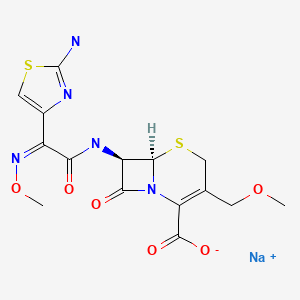Attribution Statement: LactMed is a registered trademark of the U.S. Department of Health and Human Services.
NCBI Bookshelf. A service of the National Library of Medicine, National Institutes of Health.
Drugs and Lactation Database (LactMed®) [Internet]. Bethesda (MD): National Institute of Child Health and Human Development; 2006-.
CASRN: 82619-04-3

Drug Levels and Effects
Summary of Use during Lactation
Limited information indicates that cefpodoxime produces low levels in milk and is not be expected to cause any adverse effects in breastfed infants. Occasionally disruption of the infant's gastrointestinal flora, resulting in diarrhea or thrush have been reported with cephalosporins, but these effects have not been adequately evaluated. Cefpodoxime is acceptable in nursing mothers.
Drug Levels
Maternal Levels. According to the manufacturer, levels of cefpodoxime in the milk of 3 nursing mothers were 0%, 2% and 6% of concomitant maternal serum levels at 4 hours following a 200 mg oral dose of cefpodoxime proxetil. At 6 hours after the dose, levels were 0%, 9% and 16% of concomitant maternal serum levels. No study details or measured milk levels were provided. After a 200 mg oral dose, the average peak serum level is 2.3 mg/L. Using this serum level and the maximum reported milk to plasma ratio of 0.16 above, a fully breastfed infant would receive a maximum daily dose of about 0.055 mg/kg daily after a maternal dose of 200 mg, compared to the recommend treatment dosage of 10 mg/kg daily for infants of 2 months or older.
Infant Levels. Relevant published information was not found as of the revision date.
Effects in Breastfed Infants
Relevant published information was not found as of the revision date.
Effects on Lactation and Breastmilk
Hyperprolactinemia and bilateral galactorrhea occurred in a nonpregnant, 40-year-old woman taking cefpodoxime 200 mg twice daily for 2 days. Seven days after stopping the drug, galactorrhea ceased and the serum prolactin dropped markedly into the normal range. One month later it had dropped further. Because no other cause could be found, the authors determined that the galactorrhea and hyperprolactinemia were probably caused by cefpodoxime.[1]
A 22-year-old woman who had been taking slow-release venlafaxine 150 mg daily for 3 months reported bilateral breast engorgement and galactorrhea for 3 days after being prescribed cefpodoxime 200 mg twice daily for 14 days 2 weeks prior. Laboratory and head CT results were normal except for a slight elevation in alkaline phosphatase and an elevated serum prolactin level. Her galactorrhea began decreasing within 2 weeks and disappeared in 3 weeks with no change in venlafaxine dosage. Her serum prolactin level also returned to normal. The authors felt that her symptoms and hyperprolactinemia were probably caused by cefpodoxime.[2]
The prolactin level in a mother with established lactation may not affect her ability to breastfeed.
Alternate Drugs to Consider
References
- 1.
- Khurana V, Gambhir IS. Cefpodoxime-induced hyperprolactinemic galactorrhea. Ann Intern Med 2010;152:136. Letter. PMID: 20083845. [PubMed: 20083845]
- 2.
- Das N, Chadda RK. Hyperprolactinemic galactorrhea associated with cefpodoxime in a patient with recurrent depressive disorder on venlafaxine monotherapy: A case report. J Clin Psychopharmacol. 2020;40:635–6. [PubMed: 33065718]
Substance Identification
Substance Name
Cefpodoxime
CAS Registry Number
82619-04-3
Disclaimer: Information presented in this database is not meant as a substitute for professional judgment. You should consult your healthcare provider for breastfeeding advice related to your particular situation. The U.S. government does not warrant or assume any liability or responsibility for the accuracy or completeness of the information on this Site.
- User and Medical Advice Disclaimer
- Drugs and Lactation Database (LactMed) - Record Format
- LactMed - Database Creation and Peer Review Process
- Fact Sheet. Drugs and Lactation Database (LactMed)
- Drugs and Lactation Database (LactMed) - Glossary
- LactMed Selected References
- Drugs and Lactation Database (LactMed) - About Dietary Supplements
- Breastfeeding Links
- PubChem SubstanceRelated PubChem Substances
- PubMedLinks to PubMed
- Review Ceftizoxime.[Drugs and Lactation Database (...]Review Ceftizoxime.. Drugs and Lactation Database (LactMed®). 2006
- Review Cefotaxime.[Drugs and Lactation Database (...]Review Cefotaxime.. Drugs and Lactation Database (LactMed®). 2006
- Review Cefditoren.[Drugs and Lactation Database (...]Review Cefditoren.. Drugs and Lactation Database (LactMed®). 2006
- Review Ceftriaxone.[Drugs and Lactation Database (...]Review Ceftriaxone.. Drugs and Lactation Database (LactMed®). 2006
- Review Cefdinir.[Drugs and Lactation Database (...]Review Cefdinir.. Drugs and Lactation Database (LactMed®). 2006
- Cefpodoxime - Drugs and Lactation Database (LactMed®)Cefpodoxime - Drugs and Lactation Database (LactMed®)
Your browsing activity is empty.
Activity recording is turned off.
See more...
